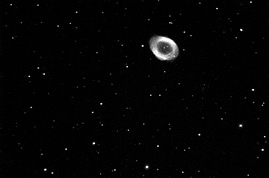 Telescope Mount Makes Science Possible Telescope Mount Makes Science Possible
The telescope in the NMU observatory on the roof of West Science has a new mount, enabling it to follow the sky’s motion more accurately—within small fractions of a degree—so it can be used to take time-exposure photographs. Mark Jacobs (Physics) is pictured between physics student Amelia Shirtz, who assisted with the project, and freshman fellow Andi Shepherd.
“We’re actually able to do science with this now,” said Jacobs, who teaches astronomy and spent a one-year sabbatical working on the project. “In its previous state, it was only good enough for observations by eye—more for entertainment value than science. But the most interesting things in the sky are not visible to the eye, even with a telescope, and no one practices professional astronomy that way anymore."
Jacobs said the old mount wasn’t properly balanced or capable of being finely adjusted to achieve the pinpoint accuracy required to use a camera that can show the dim objects. After looking at commercially available options for a new one, he decided to custom-design the equipment. It became an interdisciplinary project when he recruited Cale Polkinghorne’s (Engineering Technology) expertise in cutting and welding the steel, as pictured below.
 “It was something neither of us could have done alone,” said Jacobs.” It’s fun to see inside someone else’s world once in a while. I spent many afternoons in the machine shop at Jacobetti.” “It was something neither of us could have done alone,” said Jacobs.” It’s fun to see inside someone else’s world once in a while. I spent many afternoons in the machine shop at Jacobetti.”
The “surprisingly low-budget” effort cost less than $1,000, but will enhance the potential for research and possibly lead to advanced astronomy courses beyond the introductory level currently offered. Jacobs said an example of a practical use for the new system might be studying variable stars, which slowly cycle from bright to dim. Students could measure the length of the cycle and the extent of variation between a star’s highest and lowest light output.
Shirtz is making a light box to calibrate the camera and optimize its pixel-to-pixel sensitivity. Shepherd is measuring the dark current—electronic “noise” produced by the camera even when no light is being measured. The sensitivity and dark current measurements will allow images taken with the camera to be calibrated for scientific measurements.
“More thought went into this project than I realized,” Shirtz said of the experience. “[Jacobs] has pages and pages of calculations and notes from the design phase. I learned that measurements are very important and I got to see him use equations I learned in my introductory physics class, like the center of mass.”
 A computer operates the telescope and camera. The latter replaces the telescope eyepiece, but has no built-in optics because the telescope does all of the focusing with its 16-inch diameter mirror. Jacobs said bigger mirrors are capable of capturing brighter and more detailed images. That’s why the Hubble telescope’s primary mirror, with a diameter of 94.5 inches, has produced vivid, dynamic images of planets, stars and galaxies. A computer operates the telescope and camera. The latter replaces the telescope eyepiece, but has no built-in optics because the telescope does all of the focusing with its 16-inch diameter mirror. Jacobs said bigger mirrors are capable of capturing brighter and more detailed images. That’s why the Hubble telescope’s primary mirror, with a diameter of 94.5 inches, has produced vivid, dynamic images of planets, stars and galaxies.
“That’s a totally different league, but with the renovations to our observatory, we can take pictures and get scientific information out of them. It’s not Hubble, but for us, it’s pretty good.”
Pictured above is the ring nebula, also known as M57, in the constellation Lyra. The raw 15-second exposure image was processed by Shirtz to achieve this final image. |





